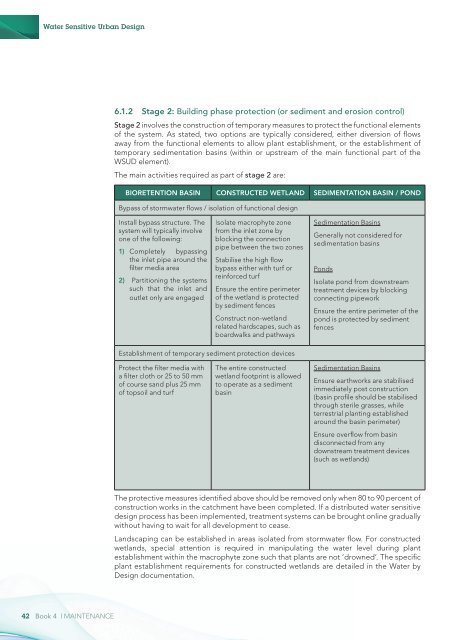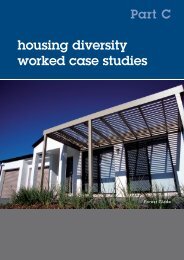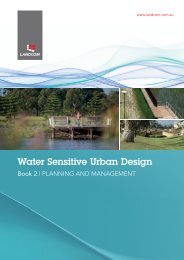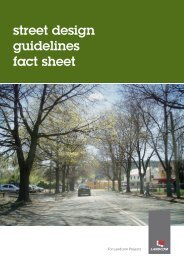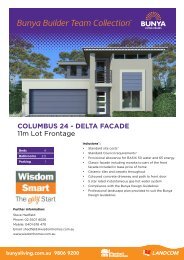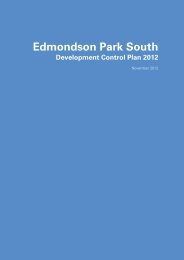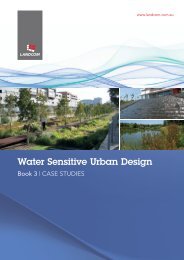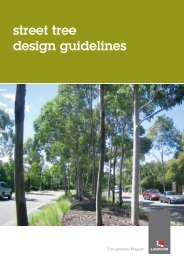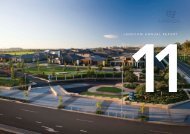Landcom Book 4 Maintenance - WSUD
Landcom Book 4 Maintenance - WSUD
Landcom Book 4 Maintenance - WSUD
You also want an ePaper? Increase the reach of your titles
YUMPU automatically turns print PDFs into web optimized ePapers that Google loves.
Water Sensitive Urban Design<br />
6.1.2 Stage 2: Building phase protection (or sediment and erosion control)<br />
Stage 2 involves the construction of temporary measures to protect the functional elements<br />
of the system. As stated, two options are typically considered, either diversion of flows<br />
away from the functional elements to allow plant establishment, or the establishment of<br />
temporary sedimentation basins (within or upstream of the main functional part of the<br />
<strong>WSUD</strong> element).<br />
The main activities required as part of stage 2 are:<br />
Bioretention basin Constructed wetland Sedimentation basin / pond<br />
Bypass of stormwater flows / isolation of functional design<br />
Install bypass structure. The<br />
system will typically involve<br />
one of the following:<br />
1) Completely bypassing<br />
the inlet pipe around the<br />
filter media area<br />
2) Partitioning the systems<br />
such that the inlet and<br />
outlet only are engaged<br />
Isolate macrophyte zone<br />
from the inlet zone by<br />
blocking the connection<br />
pipe between the two zones<br />
Stabilise the high flow<br />
bypass either with turf or<br />
reinforced turf<br />
Ensure the entire perimeter<br />
of the wetland is protected<br />
by sediment fences<br />
Construct non-wetland<br />
related hardscapes, such as<br />
boardwalks and pathways<br />
Sedimentation Basins<br />
Generally not considered for<br />
sedimentation basins<br />
Ponds<br />
Isolate pond from downstream<br />
treatment devices by blocking<br />
connecting pipework<br />
Ensure the entire perimeter of the<br />
pond is protected by sediment<br />
fences<br />
Establishment of temporary sediment protection devices<br />
Protect the filter media with<br />
a filter cloth or 25 to 50 mm<br />
of course sand plus 25 mm<br />
of topsoil and turf<br />
The entire constructed<br />
wetland footprint is allowed<br />
to operate as a sediment<br />
basin<br />
Sedimentation Basins<br />
Ensure earthworks are stabilised<br />
immediately post construction<br />
(basin profile should be stabilised<br />
through sterile grasses, while<br />
terrestrial planting established<br />
around the basin perimeter)<br />
Ensure overflow from basin<br />
disconnected from any<br />
downstream treatment devices<br />
(such as wetlands)<br />
The protective measures identified above should be removed only when 80 to 90 percent of<br />
construction works in the catchment have been completed. If a distributed water sensitive<br />
design process has been implemented, treatment systems can be brought online gradually<br />
without having to wait for all development to cease.<br />
Landscaping can be established in areas isolated from stormwater flow. For constructed<br />
wetlands, special attention is required in manipulating the water level during plant<br />
establishment within the macrophyte zone such that plants are not ‘drowned’. The specific<br />
plant establishment requirements for constructed wetlands are detailed in the Water by<br />
Design documentation.<br />
42 <strong>Book</strong> 4 | MAINTENANCE


